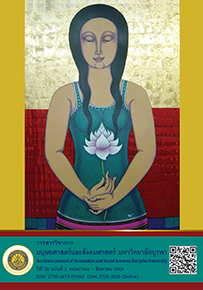A Study of Basic Korean Vocabularies for Dentistry in Teaching Korean Translation and Interpretation: An Analysis of the High-Frequently Used Nouns in the Corpus
Main Article Content
Abstract
The objective of this research were to 1) collect and analyze the frequency of occurrence of Korean and Thai vocabularies for dentistry found on dental clinic websites and in YouTube videos, and 2) to construct a corpus of basic dental terminology, particularly the high-frequency nouns that are essential for teaching Korean translation and interpretation. The data were collected from different types of electronic sources, such as websites, including 4 Korean dental clinic websites and 4 Thai dental clinic websites. To build a corpus for the analysis, the data were also collected from conversations between dentists and patients in 60 YouTube videos, comprising 30 videos in Korean and 30 videos in Thai. The findings revealed that there were 1,246 nouns with the frequency of occurrence of 7,654. In addition, 130 high-frequency words from the corpus of basic dental terminology were found with the occurrence of 6,127. The Korean noun with the highest frequency is ‘치아’, with the occurrence of 680, and the Thai noun that has the highest frequency is ‘ฟัน’, with the occurrence of ‘1,680’.
Downloads
Article Details

This work is licensed under a Creative Commons Attribution-NonCommercial-NoDerivatives 4.0 International License.
บทความทุกบทความเป็นลิขสิทธิ์ของวารสารวิชาการมนุษยศาสตร์และสังคมศาสตร์ มหาวิทยาลัยบูรพาเท่านั้น
References
กรมสนับสนุนบริการสุขภาพ. (2560). สบส. คุมเข้มมาตรฐานคลินิกทันตกรรมน้อมนำพระราชดำรัสพ่อหลวงมุ่งสร้างฟันดีประชาชน. https://hss.moph.go.th/show_topic.php?id=630
จอมขวัญ ศุภศิริกิจเจริญ และบุญเสริม บุญเจริญผล. (2558). ปัจจัยที่มีอิทธิพลต่อการใช้บริการทางการแพทย์ในโรงพยาบาลเอกชนไทยของผู้รับบริการที่เป็นชาวต่างชาติ. วารสารวิจัยและพัฒนา มหาวิทยาลัยราชภัฏเลย, 10(32), 114-123.
ทองทิพย์ พูลลาภ. (2559). ความต้องการล่ามในตลาดแรงงานไทย: การศึกษาประกาศรับสมัครงานออนไลน์. วารสารอักษรศาสตร์, 45(2), 263-303.
นนทณี ศรีนนท์ประเสริฐ. (2559). คุณลักษณะของล่ามภาษาญี่ปุ่นชาวไทยที่หัวหน้าชาวญี่ปุ่นของธุรกิจการผลิตที่อยู่ในอุตสาหกรรมอีสเทิร์นซีบอร์ดที่ประสงค์ให้มี. [งานนิพนธ์บริหารธุรกิจมหาบัณฑิต, มหาวิทยาลัยบูรพา].
เนติมา บูรพาศิริวัฒน์. (2563). การศึกษาความต้องการล่ามภาษาเกาหลีของตลาดแรงงานในประเทศไทย: การศึกษาประกาศรับสมัครงานออนไลน์. วารสารภาษาและวัฒนธรรมเกาหลีศึกษา, 2(1), 153-173.
ปรีมา มัลลิกะมาส และวิโรจน์ อรุณมานะกุล. (2546). ผลของการใช้คลังข้อมูลภาษาเฉพาะด้านภาษาอังกฤษที่มีต่อความเข้าใจเนื้อหาของต้นฉบับและความสามารถในการใช้ภาษาสำหรับแปล. จุฬาลงกรณ์มหาวิทยาลัย.
ผู้จัดการออนไลน์. (2564). ธุรกิจการแพทย์และความงาม-ธุรกิจอีคอมเมิร์ซ ครองแชมป์ธุรกิจดาวรุ่งปี 65. https://mgronline.com/business/detail/9640000124328
มลิวัลย์ ภักดิ์ประไพ. (2519). ความถี่ของคำศัพท์จากหนังสืออ่านในเวลาวิชาภาษาอังกฤษ โรงเรียนมัธยมแบบประสม มัธยมศึกษาตอนต้น. [วิทยานิพนธ์ครุศาสตรมหาบัณฑิต, จุฬาลงกรณ์มหาวิทยาลัย].
วิโรจน์ อรุณมานะกุล. (2545). ภาษาศาสตร์คลังข้อมูล. คณะอักษรศาสตร์ จุฬาลงกรณ์มหาวิทยาลัย.
สำนักงานส่งเสริมการค้าในต่างประเทศ ณ กรุงโซล. (2562). รายงานธุรกิจบริการผู้สูงอายุ ในเกาหลีใต้ (silver industry). https://www.ditp.go.th/contents_attach/468470/468470.pdf
สำนักงานสถิติแห่งชาติ. (2563). สํารวจอนามัยและสวัสดิการ พ.ศ. 2562. http://www.nso.go.th/sites/2014/Pages/News/2562/N14-03-62-1.aspx
สิริขวัญ สงวนผล. (2555). ญี่ปุ่นกับการให้บริการล่ามทางการแพทย์เพื่อผู้ป่วยชาวต่างชาติ. วารสารญี่ปุ่นศึกษา, 29(2), 92-107.
Go, S. (2007). 광주 외국인 노동자 건강 센터의 치과 진료사업 현황 [Status of dental service at foreign worker health center in Gwangju]. [Master’s thesis, Chonnam National University].
Im, A. (2011). 치과 위생사의 다문화에 대한 인식과 교육실태 조사 [Dental hygienists’ multicultural awareness and actual condition survey of education]. [Master’s thesis, Dankook University].
Kang, H., & Hong, H. (2015). 한국어능력시험 (TOPIK) 어휘 분석 연구 [A study on vocabulary analysis of the Test of Proficiency in Korean (TOPIK)]. 한국사전학 [Journal of Korealex], 25, 7-38.
Kim, E. (2014). 태국인 한국어 학습자의 어휘 오류 연구 [A study on vocabulary errors of Korean learners of Thai]. [Master’s thesis, Kyung Hee University].
Kim, M. (2016). 의료 분야 태국어 교육을 위한 기본 어휘 연구-미용성형외과를 중심으로 [A study of basic Thai vocabulary for the learners in medical field: Focus on cosmetic surgery]. [Master’s thesis, Hankuk University of Foreign Studies].
Kim, M. (2020). 국어 학습자를 위한 일기예보 말뭉치 구축 및 어휘 분석 [Constructing of weather forecast corpus and vocabulary analysis for Korean learners]. 대학교양교육연구 [Journal of Liberal Arts Education Studies], 5(2), 73-99.
Lee, E. (1972). 국민학교 학습용 기본어휘 연구 [Basic Korean words in elementary education]. 국어교육 [Korean Language Education], 18, 551-563.
Lee, H. (2014). 여성 결혼 이민자를 위한 병원·약국 어휘망 구축 [A lexical network of hospital· pharmacy for female marital immigrants]. [Master’s thesis, Sangmyung University].
Oh, J. (2012). 외국인의 보건의료기간 이용을 위한 한국어 교육 방안 연구 [A study on Korean language education plan to health service utilization for foreigners]. [Master’s thesis, Busan University of Foreign Studies].
Park, H. (2015). 학문 목적 한국어 학습자를 위한 학습어 선정 및 교육 방안 연구: 한국어 교재에 제시된 학습어의 말뭉치 구축을 통하여 [The effective academic vocabulary instruction in academic discourse for Korean language learners - A corpus-based study of academic vocabulary in Korean textbooks]. [Doctoral dissertation, Chungbuk National University].
Schmitt, N. (2000). Vocabulary in language teaching. Cambridge University Press.
Seo, S., & Han, Y. (1999). 국어정보학 입문-인문학과컴퓨터 [Introduction to Korean informatics: Human-computer interaction]. 태학사 [Taehak-sa].
Song, Y. (2004). 한국어능력시험 (TOPIK) 어휘 분석 연구 [A comparative study of Korean and Japanese medical terms]. 한국일어일문학회 [Journal of Japanese Language and Literature], 50(2), 107-125.
Wilson, G., & Wilson, A. (1971). Teaching English to foreigners. B.T.Batsford.
Yoon, B. (2016). 의료 관광 한국어 교재 개발 방안 연구 : 중국인 의료 관광 코디네이터를 대상으로 [A study on developing medical tourism Korean language textbooks - focused on Chinese medical tourism coordinators]. [Master’s thesis, Keimyung University].


